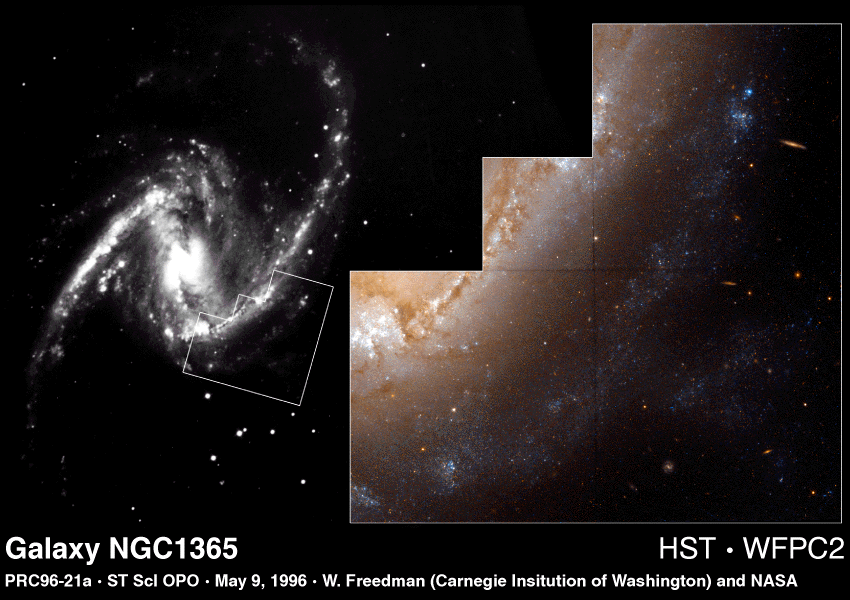My first thought was 'Why isn't there more light?' from such a long exposure and that naturally leads to a question you are going to get from your teenager once they are presented with the knowledge that the universe is 'infinite' and so are all those stars; if the universe is infinite and just one galaxy, our own Milky Way, has 50 stars for every person currently on earth, how can it ever get dark? Light is traveling at us at all times from lots of stars both near and far and has been doing so for billions of years. In an infinite universe, everywhere we look should be filled with light from stars by now. There should be no day or night, it should just be constant. Compared to the light of an infinite number of stars, a full moon is meaningless.
Distance and pictures make little sense to many people outside astronomy, because we are 'seeing' things that happened a long time ago and the light is just reaching us, so a better metric is needed, and Americans have just such a thing. Europeans are baffled when they ask how far it is from Sacramento to San Francisco, for example, and we reply '60 minutes', because they expected kilometers or miles. But time gives them a meaningful answer. They really want to know how long it takes to get from one place to another. So it goes with understanding astronomy. Making a young person memorize that the Earth is 93 million miles from the Sun is pointless, it has no context, it is just a number. But 8.3 minutes for light to reach us from the Sun has some value, it is a manageable digit and they can calculate actual distance from one number - by learning the speed of light - along with the distance of any place else. A blip on the Sun will be evident here in 8.3 minutes, that is what people want to know, they aren't getting in a rocket ship and vacationing there.
Copernicus had wondered about the 'why is there a nighttime at all?' light issue also, once he realized that the sun does not revolve around us. The answer for astronomers then is the same as most people would respond now; the stars are too faint. Kepler instead said the universe was not infinite.
Since I struggle with the perfect metaphor, I turned to "Paradox" by Professor Jim Al-Khalili of the University of Surrey. Sure enough, this mystery, named "Olber's Paradox", is in there. While Heinrich Olbers was not the first, but he tackled the problem before we knew that stars clustered in galaxies and that there are billions of galaxies, making the 'why does it get dark?' question even more mind-blowing. So he gets the name.
Prof. Al-Khalili 's metaphor for the 'why is it dark at night?' paradox is to imagine shooting an arrow in an infinite forest. That arrow is going to hit a tree. With light, you reverse it and the 'arrows of light' from an infinite forest are all shooting at you. You should never not see a brightly lit sky.
A nice way to picture it but we quickly run into a problem today; we know the universe is space with some stuff in it and and gravity is a force, but a special sort of force in physics - more like how space shapes around mass. The universe is not shrinking, as it would if gravity were the force we perceive on earth happened on a cosmological scale. Einstein postulated there was an 'anti-gravity' to explain why the universe was not known to be shrinking, and others have come up with newer and better explanations, but the idea that the universe is expanding is how we resolve the paradox of why it gets dark at night. If the universe is expanding, there must have been a Big Bang - and the ratios of hydrogen and helium observed today, which didn't need to be cooked inside stars, show that it must have happened.

From 1996, astronomers used pulsating stars called Cepheids to measure the distance to galaxies like the Fornax cluster barred spiral galaxy NGC 1365 shown above. The ground based photo (left) shows an inset locating the Hubble image (right) they used to identify some 50 Cepheids. Their distance and velocity measurements determined Hubble's constant to be about 80 kilometers per second per megaparsec which means that galaxies one megaparsec (3 million light-years) distant appear to recede from us at a speed of 80 kilometers per second. But uncertainties in the local determination of the Hubble Constant are still dominated by the uncertainty in the Cepheid P-L calibration. The Hubble Constant has changed a lot since the 1920s and will continue to change for the foreseeable future. Credit W. Freedman (Carnegie Observatories), HST Key Project Team, and NASA
So where is all the light? As space stretched in the early universe, all that original light did too and it is now in a wavelength well outside our vision - it is cosmic microwave radiation. So the sky is filled with pinholes in the cushion of night rather than being a bright white sheet because we can't see all of the light that exists and we never will - though we envision galaxies as flying away from each other in our expanding universe, it is actually space that is stretching between them.
But we know ancient, unseen light is there, even though our detectors are only sensing a small fraction of what is happening in space. In our homes, we detect it in the hiss that we sometimes get on TVs and radios: You're experiencing ancient lightwaves from the earliest moments of the universe when that happens.
Enjoy the stars!




Comments